The Imaging Resource
Quick Review
Canon PowerShot SD450 Digital ELPH Camera
| Canon PowerShot SD450 Digital ELPH Camera | ||
| Review Date |
|
|
| User Level |
|
|
| Product Uses |
|
|
| Digital Camera Design |
|
|
| Picture Quality |
Very Good, 5.0-megapixel CCD | |
| Print Sizes |
Very Good, 11x17s or 8x10s with heavy cropping | |
| Availability |
|
|
| Suggested Retail Price (At introduction) |
|
|
Introduction
|
||||||||||
With the PowerShot SD550 and SD450 Digital ELPH, Canon has once again stood its stylish ELPH digital cameras on end, packing even more features into the stylish compacts. The 7.12-megapixel SD550 and 5.0-megapixel SD450 have the same shell and specs as their SD500 and SD400 predecessors (which continue to be available), but offer more options. Canon has retained their acclaimed optical viewfinder but matched it with a large 2.5-inch LCD monitor, redesigning the user interface to take advantage of the new screen. Both continue to offer the extremely unusual (and frankly, rather cool) "My Color" modes that allow you to selectively replace any color in your photo with a different one, or to make the image black and white with the exception of a single color. Overall, the SD450 is one of the more appealing subcompact digital cameras we've seen to date: Read on for all the details!
Ultra-slim and very pocket-friendly, the new Canon PowerShot SD450 features the great looks and sharp design that are a signature of Canon's ELPH cameras. Canon's self-titled "Perpetual Curve Design" means that there are few flat surfaces or right-angled corners on the camera body. Thus, the SD450 has a very smooth, comfortable feel in your hands and no large protrusions to hang on pockets. Very compact and quick on the draw (thanks to a smoothly operating retractable lens design), the Canon SD450 is a convenient point-and-shoot digital camera with a handful of extra exposure features for added flexibility. With the lens retracted, the Canon SD450's front panel is smooth and pocket friendly, and its all-metal body is rugged and durable (although it will show scratches, so a soft case is recommended). Equipped with a 5.0-megapixel CCD, the Canon SD450 captures high quality images, suitable for making sharp prints as large as 11x17 inches, or 8x10 inches with some cropping. Smaller image sizes are also available for email transmission or Web applications, and a movie mode captures video clips with sound.
The Canon SD450 features a 3x, 5.8-17.4mm zoom lens, equivalent to a 35-105mm zoom on a 35mm camera. Aperture is automatically controlled, but the maximum setting ranges from f/2.8 at full wide angle to f/4.9 at full telephoto. A maximum 4x digital zoom option increases the SD450's zoom capability to 12x, but keep in mind that digital zoom decreases the overall image quality, because it simply crops out and enlarges the center pixels of the CCD's image. Image details are thus likely to be softer when using digital zoom. Focus ranges from 1.0 feet (30 centimeters) to infinity in normal AF mode, and from 1.2 inches to 1.6 feet (3 to 50 centimeters) in Macro mode. (The minimum focal distance in Macro mode depends on the zoom setting, however, with the closest range only available at full wide angle.) Digital Macro mode locks the lens at wide angle, where focusing is closest, but enables digital zoom, which usually only kicks in after optical zoom has reached its telephoto setting. As with the regular digital zoom, this is accompanied by a decrease in overall image quality. An Infinity fixed-focus mode is also available. The Canon SD450 employs a sophisticated, nine-point AiAF (Artificial Intelligence Autofocus) system to determine focus, which uses a broad active area in the center of the image to calculate the focal distance (a feature I've been impressed with on many ELPH models and have been happy to see continued). Through the Record menu, you can turn AiAF off, which defaults the autofocus area to the center of the frame. Also built-in to the SD450 is an AF assist light -- a very bright orange LED -- which aids the focus mechanism in low light when it's enabled via a menu option. For composing images, the SD450 offers a real-image optical viewfinder, as well as a large 2.5-inch color LCD monitor. The LCD reports a fair amount of camera information, but excludes exposure information such as aperture and shutter speed. In Playback mode, a histogram display reports the tonal distribution of a captured image, useful in determining any over- or under-exposure.
Because the ELPH line capitalizes on ease of use, exposure control is typically automatic, increasing the line's appeal to point-and-shoot users. The Canon PowerShot SD450 sticks to this trend, with a handful of unique Scene modes, but also provides a few manual adjustments. Main camera modes are controlled by a Mode switch on the camera's rear panel. Choices include Still Record, Movie, and Playback. Within Still Record mode, you can opt for Auto or Manual exposure control (Manual in this case only extending the Record menu options), or Digital Macro, Portrait, Night Snapshot, My Colors, Scene, and Stitch Assist options. Shutter speeds range from 1/1,500 to 15 seconds, with the one- to 15-second end of the range only available in Long Shutter mode (which also automatically invokes a Noise Reduction system to eliminate excess image noise in longer exposures). In straight Auto mode, the camera controls everything about the exposure except for file size, flash, etc. Manual mode provides more hands-on control, with White Balance, Exposure Compensation, ISO, and some creative effects, but it is not true manual control because the user is not allowed to set the aperture or shutter speed settings. (The camera does report the selected shutter speed however, when the Shutter button is halfway pressed.) Camera operation is straightforward, as you typically just point and shoot most of the time. Pressing the Shutter button halfway sets focus and exposure, and the small LEDs next to the optical viewfinder let you know when the camera is ready to take the picture.
The Scene modes tweak exposure variables to accommodate common photographic situations. In Portrait mode, the PowerShot SD450 opts for a large aperture to blur the background, making the subject stand out. Night Snapshot mode uses the camera's flash and higher sensitivity if necessary to try to obtain an exposure with your subject and a dark background correctly exposed. Kids & Pets mode opts for a faster shutter speed to freeze quick motion. Indoor mode biases the white balance system toward tungsten or fluorescent lighting, attempts to reduce camera shake with wider apertures and higher sensitivity, and avoids using flash where possible. In Foliage mode, saturation is boosted to offer bold colors in foliage. Snow and Beach modes both bias exposure so that the camera is not fooled into underexposing images because of a bright background; Snow mode also adjusts white balance appropriately. Fireworks mode uses a long exposure to capture the trails of fireworks. Finally, Underwater mode -- designed for use with an optional underwater housing -- uses a white balance setting appropriate for correcting the cool tones of an underwater photo, and also attempts not to use the camera's flash.
The Canon PowerShot SD450 uses an Evaluative metering system by default, which means that the camera divides the image area into zones and evaluates both contrast and brightness among all the zones to determine the best overall exposure. A Spot metering option ties the exposure to the very center of the frame, and is useful for off-center or high contrast subjects, letting you pinpoint the exact area of the frame to base the exposure on. There's also a Center-Weighted metering option, which bases the exposure on a large area in the center of the frame. Exposure Compensation increases or decreases the overall exposure from -2 to +2 exposure equivalents (EV) in one-third step increments. A White Balance option offers Auto, Daylight, Cloudy, Tungsten, Fluorescent, Fluorescent H, and Custom (manual) settings. The Canon SD450 also offers a creative Photo Effects menu, which adjusts sharpening, color, and saturation. Sensitivity equivalents include 50, 100, 200, and 400 ISO settings, as well as an Auto setting. The SD450's built-in flash operates in Auto, Red-Eye Reduction, Forced On, Forced On with Red-Eye Reduction (in Scene modes only), Suppressed, and Slow-Synchro modes.
The "My Colors" mode, accessed through the Function menu, is available for both still image and movie shooting. This mode offers nine settings: Positive Film, Lighter Skin Tone, Darker Skin Tone, Vivid Blue, Vivid Green, Vivid Red, Color Accent, Color Swap, and Custom Color. The Positive Film setting attempts to replicate the bold colors of positive film in the red, green, and blue channels. The Lighter Skin Tone and Darker Skin Tone settings attempt to alter skin tones appropriately, without affecting the rest of the photo. The Vivid Blue, Vivid Green and Vivid Red options emphasize saturation in one channel only. Most unusual are the Color Accent and Color Swap features, however. In the PowerShot SD450's Color Accent mode, you place a small square in the center of the camera's LCD over a color you want to accent, and press the left arrow on the Four-way navigation controller. A narrow band of colors surrounding the color you selected will remain untouched in the final image; the rest of the photo will be in black and white. In Color Swap mode, you similarly select two colors with the square at the center of the LCD (one by pressing the left arrow; the other with the right arrow). The camera will then replace one color with the other in your final image -- for example allowing you to make a green car appear blue. Both effects allow a little fine control over the color you selected using the left arrow key; you use the up and down arrows to slightly adjust the color you want to accent or swap. You can't, however, fine-tune the color you want to replace the swapped color with for Color Swap mode. Both the Color Accent and Color Swap modes are rather fun, and they're definitely very unusual, but the effects can be rather unpredictable. You generally end up with a slight fringe of the old color surrounding your replaced color in Color Swap mode, and it can be difficult to control the exact color you want to affect in both modes. For this reason, it is rather nice that Canon has provided the ability to set the PowerShot SD450 through the Record menu to capture a duplicate copy of images captured in My Colors mode, without any color changes made. If you end up throwing away your color-altered image, you'll still have your original source image to change with an image editor, or just enjoy in a more normal manner. Finally, the Custom Color mode allows you to manually fine-tune the saturation of colors in the Red, Green and Blue channels (plus the saturation of skin tones), with five steps of control over each.
A two- or 10-second self-timer option counts down by flashing a small LED on the front of the camera before firing the shutter, giving you time to duck around the camera and get into your own shots. In addition, a Custom timer function allows you to set the camera for a delay of 0-10, 15, 20 or 30 seconds, and a number of photos to be captured once the delay has been elapsed (from one to 10). After the timer expires, the PowerShot SD450 will capture the number of photos requested with an interval of approximately one second between photos, and the flash does recharge quickly enough to capture 10 photos in a row with flash. This could be rather nice for people trying to take photos of a large family gathering -- 30 seconds gives you plenty of time to get into your photo, and with the ability to capture ten images with one press of the shutter, there's a better chance you'll get a shot where nobody blinked or made a funny face.
Stitch-Assist mode is the Canon SD450's panoramic shooting mode, which lets you shoot as many as 26 consecutive images, oriented either left to right or right to left. As each image is captured, a portion of it appears alongside a live preview of the current scene, helping you to line the next image up with a proper overlap. The series of images can then be "stitched" together into a single panoramic frame with the accompanying software. A Continuous Shooting mode captures a series of consecutive images (much like a motor drive on a traditional camera), at approximately 2.1 frames per second, for as long as the Shutter button is held down. The actual frame rate varies slightly with the resolution setting, and the maximum number of images will also depend on the amount of memory card space and file size.
The Canon SD450 also has four Movie Record modes, which record moving images with sound. Focus and optical zoom are fixed at the first frame. Movie modes include Standard (either 640 x 480 or 320 x 240 pixels at either 30 or 15 fps, up to 1GB each), Fast Frame Rate (320 x 240 pixels at 60 fps for up to one minute), Compact (160 x 120 pixels at 15 fps for up to three minutes), and My Colors (either 640 x 480 or 320 x 240 pixels at either 30 or 15 fps, up to 1GB each). The PowerShot SD450's Playback mode allows cropping of movies, with a minimum length of two seconds for the cropped movie. You can preview the change, and opt to save the new movie over the old one, or as a new file. During playback, you can also step through images frame by frame, and you can play them at one of four reduced frame rates (without sound).
The My Camera settings menu lets you customize camera settings to a specific theme. Everything from the startup image to operating sounds can be assigned to a theme, either one of the pre-programmed themes or one downloaded from the camera software or stored on the memory card. The PowerShot SD450 also lets you record short sound clips in WAV format to accompany captured images, via the Sound Memo option, great for lively captions to vacation photos or party shots.
The Canon PowerShot SD450 stores images on SD memory cards (hence, the "SD" in its name). A 16MB card accompanies the camera, but I highly recommend picking up a larger capacity card, so you don't miss any shots. These days, 128 to 256 MB is a good tradeoff between cost and capacity. The camera utilizes a rechargeable lithium-ion battery pack for power, which accompanies the camera, along with the necessary battery charger. Because the Canon SD450 does not accommodate AA-type or any other off-the-shelf battery format, I strongly advise picking up an additional battery pack and keeping it freshly charged. The optional AC adapter kit is useful for preserving battery power when reviewing and downloading images, and actually uses a "dummy" battery that inserts into the camera's battery compartment. A USB cable and interface software are also packaged with the camera, for downloading images to a computer and performing minor organization and corrections. A software CD accompanies the camera and provides the necessary drivers and editing software, both compatible with Windows and Macintosh platforms. The CD holds Canon's Digital Camera Solution Disk version 26.0 and also features ArcSoft's PhotoStudio. Finally, an A/V cable connects the SD450 to a television set, for reviewing and composing images. The Canon SD450 is Digital Print Order Format (DPOF) and PictBridge compatible, with detailed print settings in the Playback menu. Canon offers a selection of direct-connect printers as well, which simplifies printing even more.
Basic Features
- 5.0-megapixel CCD
- Real-image optical viewfinder
- 2.5-inch color TFT LCD monitor
- 3x, 5.8-17.4mm lens, equivalent to a 35-105mm lens on a 35mm camera
- Maximum 4x digital zoom
- Automatic exposure control, with Long Shutter mode for longer exposures
- Shutter speeds from 1/1,500 to 15 seconds
- Maximum aperture of f/2.8 to f/4.9, depending on lens zoom position
- Built-in flash with six modes
- SD memory card storage, 16MB card included
- Power supplied by a rechargeable lithium-ion battery pack (charger included) or optional AC adapter kit
- Canon Digital Camera Solution Software v26.0 with ArcSoft PhotoStudio, and USB drivers included for both Windows and Mac platforms
- Print/Share button
Special Features
- Four Movie modes with sound (up to 640 x 480 pixels, at up to 30 frames per second with a 60-fps Fast Frame Rate mode)
- Continuous Shooting mode
- Stitch-Assist panorama mode
- Infinity and Macro focus modes plus "Digital Macro" mode
- Customizable "My Camera" settings
- Two- or 10-second Self-Timer for delayed shutter release, plus custom timer with multi-shot feature
- Sound Memo option for recording captions
- Spot, Center-Weighted, and Evaluative exposure metering
- White balance (color) adjustment with seven modes, including a Custom setting
- Photo Effect and My Colors menus for color adjustment
- Unusual Color Accent and Color Swap features for special effects in still images or movies
- Adjustable ISO setting
- DPOF (Digital Print Order Format) and PictBridge compatibility
- USB cable for connection to a computer (driver software included)
- A/V cable for connection to a television set
Recommendation
The Canon ELPH series of digital cameras continues to be a popular option for many consumers, given its tiny size and reputation for great quality. Although exposure control is mainly automatic, the availability of exposure times as long as 15 seconds and adjustable ISO increases the PowerShot SD450's exposure versatility a great deal. The uncomplicated user interface and smooth styling help novices and more advanced amateurs alike feel at home, with enough control over the exposure to make both happy. The Canon SD450 makes a great all around camera for anyone, and would make a good second camera for enthusiasts who don't want to lug along their full-size all-the-bells-and-whistles camera. All in all, one of the better subcompact digital cameras currently on the market.
Slightly flatter overall than the SD500 and 550, but still with nice soft curves on the edges, the Canon PowerShot SD450 is tiny and very pocket-friendly. The compact size is perfect for quickly stashing in a shirt pocket or evening bag without worrying about damaging the rugged, all-metal body (though if you want to maintain that gorgeous finish, you'll want to put it in a protective case first, because it can get scratched). The retracting lens is a smart design that keeps the camera front completely flat when the camera is off, underscoring the camera's pocket friendly design, while an automatic lens cover means you don't have to worry about smudging the lens or losing a lens cap. Measuring 3.39 x 2.11 x 0.85 inches (86 x 53 x 22 millimeters), the Canon SD450 weighs a trifling 4.93 ounces (140 grams) without battery and memory card.
Several distinctive ELPH features are on the front of the Canon SD450, with the lens off-center slightly toward the right, and both the viewfinder and flash just above it. A light emitter, next to the optical viewfinder, serves multiple purposes, including autofocus assist, red-eye reduction, and the self-timer countdown. The camera's telescoping lens moves into place quickly, projecting about 5/8-inch from the front of the camera when powered on, and retracts fully within the camera when switched off to maintain a flat profile. To the left of the lens is a tiny hole for the camera's microphone. No finger-grip is provided on the PowerShot SD450 so be sure to attach the accompanying wrist strap for security.
The Shutter button, Zoom ring, and Power button are all located at the right of the camera's top, with the former two protruding from the surface, while the latter is indented and features an LED in the center to indicate that the camera is switched on.
On the right side of the PowerShot SD450 (as viewed from the rear) are the AV Out and USB ports, concealed by a hinged, plastic door that lifts upward to reveal the ports. The door features a metallic finish, and fits very snugly back into place with a gentle press. Below the door is the wrist strap attachment eyelet.
The opposite side of the PowerShot SD450 is basically bare, with only a couple of screws visible, plus four tiny protrusions in the corners that let the camera stand vertically on its end (although we wouldn't advise trying this on anything other than a perfectly level, smooth surface -- and even then not near an edge the camera could fall off!) The text on the front of the camera and lens is actually oriented to be right reading when the camera is stood on end.
The remaining camera controls are on the PowerShot SD450's rear panel, along with the optical and LCD viewfinders. The LCD monitor is large for a subcompact camera, measuring 2.5 inches diagonally. Because of the screen size, all controls are located to the right. A Mode switch next to the top right corner of the LCD selects between Still Record, Movie, and Playback modes. Right of this is the camera's speaker. Below the switch is the Print / Share button, which features a blue LED in the center that lights when the camera is ready to print or transfer images, and blinks when either is in process. A Four-Way Arrow pad incorporates most of the quick settings, with the outside buttons handling both navigation and items like Macro, ISO, and Flash modes. The Function button nestles in the middle of the Four-way Arrow pad, also serving as the Set button for making menu selections. Below this arrangement are the Display and Menu buttons. Finally, two LED lamps next to the PowerShot SD450's viewfinder report camera status, lighting to indicate when focus is set or the flash is fully charged.
The Canon SD450 features a nice, flat bottom panel, which holds the metal tripod mount and the battery / memory card compartment. The tripod socket is centered under the lens, good for panorama shooting. Inside the battery / memory card compartment, the battery and SD memory card slots line up side by side. A small spring-loaded latch ensures the battery won't accidentally fall out when you open the compartment cover. A small, rubber flap in the center of the door covers a hole that accesses the connector jack in the "dummy battery" used in the optional AC adapter kit. (Like many other Canon digital cameras, the SD450's AC adapter scheme employs a dummy battery that fits into the battery compartment, and which provides a plug for the AC power converter's cable.) Unfortunately the tripod mount is also right alongside the battery / card compartment door, so you have to remove the camera from a tripod if the battery life or flash card space is exhausted (although in fairness, this is hardly a camera you'll shoot in a studio with anyway). Likewise, the rubber flap for the AC adapter kit is close enough to the tripod mount that when using AC power, you likely won't be able to use a tripod.
The Canon PowerShot SD450's user interface is straightforward and relatively uncomplicated, with a similar menu setup and basic control philosophy as the rest of the current ELPH series. Most of the camera's functions are controlled by buttons on the top and rear panels, while a handful of settings are controlled through the LCD-based Record menu. A Function menu provides faster access to basic settings like image size, quality, and exposure compensation, without the need to sift through menu screens. The LCD menu system itself is quite efficient, as you view menu items organized in tabs instead of through a series of pages. Additionally, the Setup and My Camera menus are always available, regardless of the camera mode. With the instruction manual in-hand, it shouldn't take more than a half an hour to an hour to get comfortable with the camera.
Record Mode Display: In any record mode, the PowerShot SD450's LCD display shows either the image area with no information, the image with a limited information display, or no display at all. Pressing the Display button cycles through the available display modes. When the information display is active, it reports resolution and image quality settings, the number of available images, Record mode, orientation, and a handful of exposure settings (although not aperture or shutter speed).
Playback Mode Display: Playback mode also offers three display modes, including the image only, the image with information, and the image with expanded information and a histogram. You can display as many as nine thumbnail images at a time on-screen with the index display mode, or zoom in on captured images to check fine details, focus, or framing. You can also jump through nine images at a time by accessing the JUMP mode. This mode is accessed by hitting the wide angle side of the zoom toggle after entering the nine-frame preview mode.
External Controls
Shutter Button: Located on the top panel, this button sets focus and exposure when halfway pressed and fires the shutter when fully pressed. If the Self-Timer is activated, a full press of the Shutter button triggers the countdown.
Zoom Lever (see image above): Surrounding the Shutter button on the camera's top panel, this lever controls the optical and digital zoom in any record mode. In Playback mode, the wide-angle end activates first a nine-image index display, and then a "jump" mode that allows you to page through screens of nine thumbnails at once. The telephoto setting zooms in on captured images for closer inspection of fine details.
Power Button (see image above): To the left of the Shutter button on the camera's top panel, this button turns the camera on or off. A green LED in the center of the button illuminates whenever the camera is powered on.
Mode Switch: Next to the top right corner of the LCD monitor on the camera's rear panel, this sliding switch controls the camera's operating mode, offering the following selections:
- Still Record Mode: Sets the camera for still image capture, with varying exposure options available through the Function menu.
- Movie Mode: Captures moving images with sound in four different modes.
- Playback Mode: Replays captured images and movies, with options for image management and printing.
Print/Share Button: Just below the Mode switch, the Print/Share button is used for activating uploads to Windows computers or connections to a variety of compatible printers, including those complying to the PictBridge standard. The button glows blue when ready to print or transfer images, and flashes blue when printing or transferring images.
Four-Way Arrow Pad: This four-way rocker button is located to the right of the PowerShot SD450's LCD monitor and serves multiple functions. In any Settings menu, the arrow keys navigate through menu selections. In Record mode, the arrow buttons control various exposure-related functions, with not all options being available in all modes. The up arrow cycles through ISO speeds from Auto to 50, 100, 200 or 400 ISO equivalents. The left arrow controls Macro and Infinity focus modes, and cycles back around to the normal AF mode. The right arrow accesses the camera's flash modes, cycling through Automatic, Red-Eye Reduction, Forced On, Forced On with Red-Eye Reduction, Forced Off, and Slow-Sync settings. Finally, the down arrow key activates the Self-Timer and Continuous Shooting modes, or returns to the normal exposure mode.
In Playback mode, the up arrow calls the Jump menu, and the down arrow calls the Delete menu, while the right and left arrow keys scroll through captured images and movie files. When you zoom in on an image, all four arrows pan the view.
Function / Set Button (see image above): Occupying the center of the four-way arrow pad, this control activates the Function menu in any record mode, and confirms selections once any menu has been invoked. When used to activate the Function menu, the following options are available (not all options being available in all modes):
Shooting Mode: Selects among the available shooting modes: Auto, Manual, Digital Macro, Portrait, Night Snapshot, My Colors, Scene, and Kids & Pets.
- Exposure Compensation: Increases or decreases the exposure from -2 to +2 exposure equivalents (EV) in one-third-step increments.
- Long Shutter: Accesses longer shutter times, with thirteen steps from one to 15 seconds. (Only appears when enabled through the Record menu, and is accessed by pressing the Menu button while the Exposure Compensation option is highlighted.)
- White Balance: Controls the color balance of images. Options are Auto, Daylight, Cloudy, Tungsten, Fluorescent, Fluorescent H, and Custom (manual setting).
- Photo Effect: Enables Vivid Color (high color saturation), Neutral Color (low color saturation), Low Sharpening, Sepia, or Black-and-White picture effects, or disables the effects altogether.
- Metering: Sets the camera's metering mode to Evaluative, Center-Weighted, or Spot.
- Compression: Sets the JPEG compression to Superfine, Fine, or Normal.
- Resolution: Specifies the image resolution. Still image resolutions are 2,592 x 1,944; 2,048 x 1,536; 1,600 x 1,200; and 640 x 480 pixels; a Postcard mode also takes the resolution to 1,600 x 1,200 and locks the resolution to Fine; a date stamp can be printed on the image in this mode, and the top and bottom of the screen are greyed out when you half-press the Shutter button, showing the portions of the image that won't fit on a 4x6 postcard. Movie resolutions are 640 x 480, 320 x 240, and 160 x 120 pixels.
Display Button: Lower left of the Four-way rocker button, this button cycles through the LCD image and information displays and in Record mode includes an LCD Off state for power saving when desired. In Playback mode, this button cycles through the image only, information display, and info display with histogram modes.
Menu Button: Lower right of the Four-way nav controls, this button accesses the LCD menu system in both Record and Playback modes.
Camera Modes and Menus
Still Record Mode: Sets the camera for image capture, with a full range of exposure and shooting options available through the on-screen menus. Exposure modes include Auto and Manual (though no direct exposure control), as well as Portrait, Night Snapshot, Kids & Pets, Scene (Indoor, Foliage, Snow, Beach, Fireworks, and Underwater), My Colors, and Stitch Assist preset shooting modes.
Movie Mode: Records short movie clips with sound in one of four modes. Focus and optical zoom are fixed at the first frame. Movie modes include Standard (either 640 x 480 or 320 x 240 pixels at either 30 or 15 fps, up to 1-GB each), Fast Frame Rate (320 x 240 pixels at 60 fps for up to one minute), Compact (160 x 120 pixels at 15 fps for up to three minutes), and My Colors (either 640 x 480 or 320 x 240 pixels at either 30 or 15 fps, up to 1-GB each).
Playback Mode: This mode allows you to scroll through captured images and movies, write-protect images, view a nine-image index display, zoom into a captured image, delete unwanted images, rotate images, set up images for printing on DPOF compatible devices, as well as play and crop movies.
Record Menu System: Accessed by pressing the Menu button in any record mode (some options are not available in all modes). Three menu tabs appear, one each for Record, Setup, and My Camera sub-menus.
Record Menu:
AiAF: Turns on the AiAF focus system. If switched off, the camera bases autofocus on the center of the frame.
- Self-Timer: Sets the Self-Timer countdown to two or 10 seconds, or lets you specify a custom timer. The custom timer can have a delay of 0-10, 15, 20, or 30 seconds, and allows multiple shots (from one to 10 in total) to be captured. If the camera is set to capture multiple shots, these are captured with an interval of about one second between shots, enough time for the flash to recharge if required. Focus and exposure are locked from the first shot. (A very handy feature for getting good shots of groups, as someone invariably blinks right as the shutter goes off.)
- AF Assist Beam: Turns the AF assist light on or off. If on, the bright orange LED on the camera's front automatically illuminates in low lighting.
- Digital Zoom: Enables the SD450's 4x digital zoom function, which is engaged by zooming past the optical zoom range. Also disables digital zoom.
- Review: Turns the instant review function on or off, sets the amount of time that the captured image is displayed on the screen from two to 10 seconds, or allows a "Hold" mode where the image remains on the screen until the shutter button is half-pressed. The instant review function applies to still images only.
Save Original: When in My Colors mode, sets the camera to save an unmodified version of each still image captured, as well as the version modified by the My Colors function.
- Grid Lines: Enables or disables display of grid lines to help align shots or compose using the rule of thirds.
- Date Stamp: Activates the Date Stamp feature, which imprints the date (and optionally, the time) on the lower right of images captured in "Postcard" mode only.
- Long Shutter: Activates Long Shutter mode, so that it appears in the Function menu.
- Stitch Assist: Enables the Stitch Assist (panoramic) shooting mode, and lets you designate whether the panorama travels left to right or right to left.
Setup Menu:
Mute: Turns the camera's beep sounds on and off.
- Volume: Individually sets Startup, Operation, Self Timer, Shutter, and Playback volumes. Five steps are available for each item, or the sound for each item can be disabled individually.
- LCD Brightness: Adjust the brightness of the LCD backlight, with 15 steps of control available.
- Power Saving: Toggles the camera's automatic shutoff function, which turns off the camera after a length of inactivity. Also sets display shutdown time to 10, 20, or 30 seconds, or to 1, 2, or 3 minutes.
- Time Zone: Sets both a Home and World (away) time zone, so you can simply select one or the other to record date and time settings for that location. Setting a time zone displays a world map with scrollable time zones and major city names for each zone, making it easy to select a location.
- Date/Time: Sets the camera's internal calendar and clock, as well as the format for dates (mm/dd/yy, dd/mm/yy, or yy/mm/dd).
- Clock Display: Controls the clock display option, which shows the current time (but not the date) for a period of 0-10, 20 or 30 seconds or for 1, 2 or 3 minutes when the Function key is pressed and held for two seconds. (Handy if you forgot your wristwatch, I guess.) If set to zero, the clock is displayed only while the Function button is held in.
Format: Formats the Secure Digital card, erasing all files (even those marked for write-protection). An optional is available to low-level format the card.
- File Numbering: Resets file numbering with each new Secure Digital card when set to Auto Reset. If set to Continuous, the camera continues numbering in sequence, regardless of memory card.
- Create Folder: Immediately creates a new folder on the memory card to store images or creates the folder at the day and time you specify.
- Auto Rotate: Toggles Auto Rotate feature on and off. The camera can detect when the camera is held approximately level, or when it is rotated left or right beyond approximately 45 degrees. If you aim the camera vertically up or down, it will remember the orientation before you did so -- hence letting you control which orientation an image is tagged with even for shots where the camera is tilted enough vertically to prevent the sensor working.
- Language: Sets the camera's menu language to one of a whopping 22 choices. English is the default setting.
- Video System: Sets the camera's video-out signal to conform to NTSC or PAL timing.
- Reset All: Resets all non-custom camera settings to their default values.
My Camera Menu
Theme: Selects a common theme for each My Camera menu settings item. Four options are available, the first one being Off. When a theme is selected, all of the following settings automatically adjust to that theme. Users can also select and upload their own sounds to the camera.
- Start-Up Image: Sets the startup image when you turn on the camera to: Black screen, Canon logo, Canon logo with sunset, and nature scene. You can also apply your own image using the Canon software.
- Start-Up Sound: Sets the startup sound when you turn on the camera to: No sound, Musical tone (1), Musical tone (2), or Birds chirping. You can also apply your own sounds using the Canon software.
- Operation Sound: Sets the sound when any control or switch is use (except the Shutter button). Options include no sound, Beep, Musical tone, and Chirp.
- Self-Timer Sound: Sets the sound that signals you when the shutter release is two seconds away. Options include no sound, Fast beeps, Telephone ring, and Howling.
- Shutter Sound: Sets the shutter sound that you hear when you depress the Shutter button (there is no shutter sound in Movie mode). Options include no sound, Shutter sound, Musical Tone, and Bark.
Playback Menu System: Accessed by pressing the Menu button in Playback mode, the Playback menu also has subject tabs for the Setup and My Camera menus. Since these were described above, I won't repeat them here.
Playback Menu:
Protect: Marks the current image for write-protection, or removes write-protection. Protected images cannot be deleted or manipulated, except through card formatting, which erases all files.
- Rotate: Rotates the current image. The first press gives a 90 degree clockwise rotation; the second press rotates the image 90 degrees counterclockwise from the original position. On the third press, the image returns to its original orientation. The image data is not actually rotated; the camera actually sets a tag in the EXIF header, hence your software must recognize this tag to be able to recognize the orientation set in-camera.
- Sound Memo: Records a short sound clip to accompany a captured image.
- Erase All: Erases all files on the memory card, except protected ones.
- Slide Show: Automatically plays all captured images in a slide show.
- Print Order: Determines how many copies of the current image will be printed, with options for creating an index print, imprinting the date and time, and imprinting the file number.
- Transfer Order: Select images for downloading to your computer.
- Transition: Select a fade or wipe transition between images as they are displayed or disable the effect.
Print Connection: When you connect the Canon SD450 to a PictBridge, Canon Direct Print, or Bubble Jet Direct-compatible printer, a new menu option is enabled, allowing easy print to a number of basic paper sizes, all without a computer. A special icon appears in the upper left hand corner, with the word SET right next to it, telling you that to adjust settings, you should press the Set button. You can select not only the size and type of paper, but you can also crop the pictures right in the camera. If you only print one size, full frame, you need only press the Print/Share button and printing of the current image begins immediately.
In the Box
Packaged with the PowerShot SD450 are the following items:
- Wrist strap
- Video cable
- USB cable
- 16MB SD memory card
- NB-4L lithium-ion battery pack with cover
- Battery charger
- Canon Digital Camera Solution Disk v26.0 software CD
- Operating manuals and registration card
- Large capacity SD/MMC memory card (These days, 128 to 256 MB is a good tradeoff between cost and capacity.)
- Additional NB-4L lithium-ion battery pack
- AC adapter kit
- Small camera case
Recommended Software: Rescue your Photos!
Just as important as an extra memory card is a tool to rescue your images when one of your cards fails at some point in the future. We get a lot of email from readers who've lost photos due to a corrupted memory card. Memory card corruption can happen with any card type and any camera manufacturer, nobody's immune. A lot of "lost" images can be recovered with an inexpensive, easy to use piece of software though. Given the amount of email I've gotten on the topic, I now include this paragraph in all my digital camera reviews. The program you need is called PhotoRescue, by DataRescue SA. Read our review of it if you'd like, but download the program now, so you'll have it. It doesn't cost a penny until you need it, and even then it's only $29, with a money back guarantee. So download PhotoRescue for Windows or PhotoRescue for Mac while you're thinking of it. (While you're at it, download the PDF manual and quickstart guide as well.) Stash the file in a safe place and it'll be there when you need it. Trust me, needing this is not a matter of if, but when... PhotoRescue is about the best and easiest tool for recovering digital photos I've seen. (Disclosure: IR gets a small commission from sales of the product, but I'd highly recommend the program even if we didn't.) OK, now back to our regularly scheduled review...
See camera specifications here.
Cycle times, shutter lag, battery life, etc. can be found here.
"Gallery" Photos
For those readers interested in a set of less "standardized" photos from the Canon PowerShot SD450, we've put together a "photo gallery" of more pictorial shots captured with the SD450 .
We ran the Canon PowerShot SD450 through our usual battery of tests, and have summarized our findings here. To see the full set of our test images, with explanations of what to look for in them, see the Canon PowerShot SD450 Sample Pictures page. For a complete listing of all our test and "gallery" shots, go to the Thumbnails page.
Not sure which camera to buy? Let your eyes be the ultimate judge! Visit our Comparometer(tm) to compare images from the SD450 with those from other cameras you may be considering. The proof is in the pictures, so let your own eyes decide which you like best!
Lens
Zoom
A typical 3x optical zoom range, with good performance.
| 35mm |
105mm |
4x Digital Zoom |
The Canon SD450 zooms over the equivalent of a 35-105mm range, which is about average for its class. Details are slightly soft at wide angle, with some noticeable corner softness, but the SD450's lens performs quite well overall. The 4x digital zoom takes it out to 12x total, albeit with the loss of quality that digital zoom creates.
Macro
A very small macro area with good detail and high resolution. Flash exposure is too bright. Digital Macro mode results in softer details.
| Standard Macro | Macro with Flash | Digital Macro |
The SD450's macro setting performs very well, capturing a small minimum area of 1.30 x 0.98 inches (33 x 25 millimeters). Detail is strong and resolution high, with only a moderate amount of softening in the corners from the lens. (Most cameras have some softening in the corners in macro mode.) The flash almost throttles down for the macro area, but remains too bright at the top of the frame. The SD450 also features a Digital Macro setting, which digitally enlarges the macro area for even closer results. However, the digital enlargement results in very soft details when viewed at 100 percent. (No surprise really, this is just "digital zoom" under another name.)
Distortion
Low barrel distortion, and no pincushion.
This is the tendency for the lens to bend straight lines outward (like a barrel--usually at wide angle) or inward (like a pincushion--usually at telephoto). The Canon SD450's 0.4% barrel distortion at wide angle is actually a little low when compared to the cameras I've tested. At the telephoto end, the SD450 has no pincushion or barrel distortion.
| Barrel distortion at 35mm is 0.4% |
| Pincushion at 105mm is 0.0% |
Chromatic aberration
Moderate at wide angle, none at telephoto. Overall, a very small effect on images at edges.
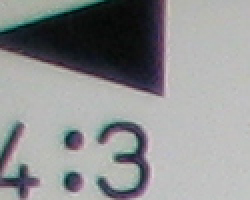 |
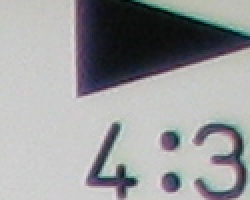 |
| Wide: moderately low, top left @ 200% | Wide: moderate, top right @ 200% |
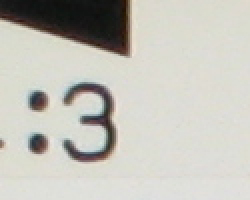 |
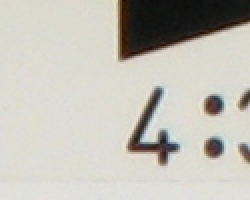 |
| Tele: virtually nonexistent, top left @200% | Tele: also quite low, top right @200% |
Chromatic aberration is moderate to moderately low at wide angle, showing about 4-5 pixels of moderately bright coloration on either side of the target lines, but decreases to very low levels at telephoto focal lengths. (This distortion is visible as a very slight colored fringe around the objects at the edges of the field of view on the resolution target.)
Corner Sharpness
Moderate blurring in the lower corners of the frame, only slight softening in the top corners.
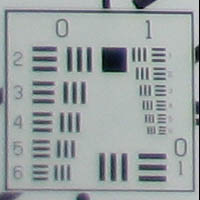 |
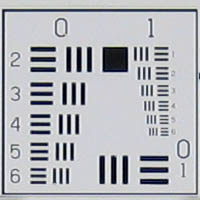 |
| Wide Angle: Moderately soft in the lower left corner. |
Wide Angle: Center (for reference) |
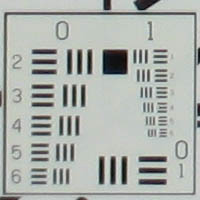 |
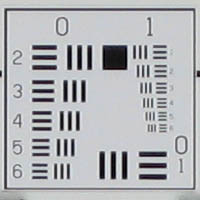 |
| Telephoto: Not bad (lower left is still the softest corner) |
Telephoto: Center (for reference) |
The Canon SD450 produced slightly soft corners in a few shots. The left corners, and particularly the lower left, were the worst at wide angle; other corners were noticeably better. All corners were pretty good at telephoto. (Noticeable light falloff in the corners though, particularly at wide angle, as seen in the crops above.) Overall corner sharpness is better than average for a subcompact digital camera with a zoom lens.
Sensor
Exposure and White Balance
Indoors, incandescent lighting
Slight warm cast with the Auto white balance setting, but excellent results with Manual and Incandescent. Much better than average overall for this light source. Less exposure compensation required than usual.
| Auto White Balance +0.7 EV | Incandescent WB +0.7 EV |
| Auto White Balance +0.7 EV |
Color balance indoors under incandescent lighting was only slightly warm in Auto white balance mode (probably acceptable to most users), though the Incandescent and Manual settings both resulted in very pleasing color. I thought the Incandescent setting was actually the most appealing, with the most natural skin tones. (Though it's very much a question of personal taste here, how much of the original color cast you want the camera to leave in there.) The Canon SD450 only required a +0.7 EV exposure compensation boost to get a good exposure, a little less than average for this shot. That exposure does leave the colors slightly dark, making the blue flowers very dark and purplish. (A very common outcome for this shot.) Our test lighting for this shot is a mixture of 60 and 100 watt household incandescent bulb, a pretty yellow light source, but a very common one in typical home settings here in the US. Overall, the SD450 does a much better than average job with this difficult light source.
Outdoors, daylight
Pretty good color balance, though a hint warm with slightly dark colors. Better than average exposure accuracy.
| Auto White Balance, +0.7 EV | Auto White Balance, Auto Exposure |
Outdoor shots generally showed accurate exposure with a tendency to blow out strong highlights. Shadow detail was also slightly limited, but not too severely. Exposure accuracy overall was better than average, the camera requiring less exposure compensation than we're accustomed to seeing with consumer digital cameras.
See full set of test images with explanations
See thumbnails of all test and gallery images
Resolution
High resolution, 1,100 - 1,200 lines of strong detail.
Our laboratory resolution chart revealed sharp, distinct line patterns down to about 1,100~1,200 lines per picture height horizontally, and to about 1,100 lines vertically. Extinction occurred at around 1,600 lines. (The PowerShot SD450 did produce slight color artifacts at lower line frequencies though, visible in the full-sized res target shots. Also, an argument could be made for higher resolution ratings, but the presence of artifacts, particularly in the vertical direction, for horizontally-oriented lines, led us to rate it lower.) Use these numbers to compare with other cameras of similar resolution, or use them to see just what higher resolution can mean in terms of potential detail. Beware that while you might be able to make out what looks like distinct lines at numbers higher than those we've mentioned here, the camera is just doing its best to continue interpreting the lines. If you zoom in and follow them from the wider portions, you'll see the lines converge and reappear several times, so the lines you see at 1,500 and higher are really only artifacts generated by the camera's imaging system.
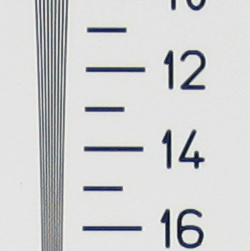 |
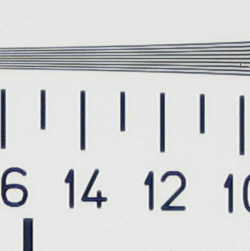 |
| Strong detail to 1,100~1,200 lines horizontal | Strong detail to 1,100 lines vertical |
See full set of test images with explanations
See thumbnails of all test and gallery images
Sharpness & Detail
Fairly sharp images overall, though some blurring of detail from noise suppression.
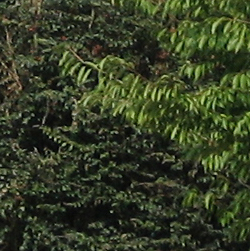 |
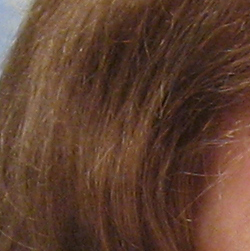 |
| Good definition of high-contrast elements. | Subtle detail: Hair Noise suppression tends to blur detail in areas of subtle contrast, as in the darker parts of Marti's hair here. |
The Canon SD450's images are fairly sharp overall, without significant over-sharpening or edge enhancement on the camera's part. (Edge enhancement creates the illusion of sharpness by enhancing colors and tones right at the edge of a rapid transition in color or tone.) The high contrast details in the fine foliage above are well-defined, without the appearance of increased contrast.
Noise-suppression systems in digital cameras tend to flatten-out detail in areas of subtle contrast. The effects can often be seen in shots of human hair, where the individual strands are lost and an almost "watercolor" look appears. The crop above right shows this, as both darker and lighter areas of Marti's hair show only limited detail, even though individual strands are quite visible against her cheek in the uncropped image.
ISO & Noise Performance
Moderate noise at the normal sensitivity settings, very high noise that blurs detail at the higher settings.
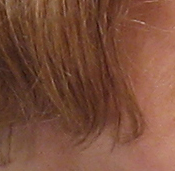 |
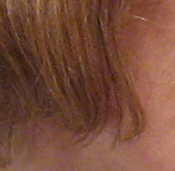 |
| ISO 50 | ISO 100 |
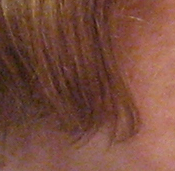 |
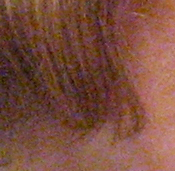 |
| ISO 200 | ISO 400 |
The Canon SD450's lower ISO settings produced only moderate noise, albeit with slightly blurred detail in the areas of subtle contrast. At the ISO 200 setting, image noise is much higher with some detail loss, and at ISO 400, noise is very high, resulting in very soft details. When printed, ISO 200 shots look a little soft but acceptable at 8x10 inches, but are very good at 5x7. ISO 400 images are a little noisy but probably acceptable for most people at 5x7 inches, good at 4x6.
Extremes: Sunlit and low light tests
Good detail and resolution, but slightly high contrast results in limited highlight and shadow detail. Good low-light performance, capable of capturing bright images under average city street lighting and slightly darker conditions.
| +0.3 EV | +0.7 EV | +1.0 EV |
Sunlight:
Because digital cameras are more like slide film than negative film (in that they tend to have a more limited tonal range), we test them in the harshest situations to see how they handle scenes with bright highlights and dark shadows, as well as what kind of sensitivity they have in low light. The shot above is designed to mimic the very harsh, contrasty effect of direct noonday sunlight, a very tough challenge for most digital cameras. (You can read details of this test here.)
The Canon SD450 had a little trouble with the deliberately harsh lighting in the test above, and produced high contrast with strong highlights and deep shadows. Noise suppression contributes to the loss of detail in the shadows as well. The camera did not wash out the highlights when exposure compensation was set to +0.3 EV, but the resulting exposure was just too dim overall. (In "real life" though, be sure to use fill flash in situations like the one shown above; it's better to shoot in the shade when possible.)
Low light:
The Canon SD450 performed well here, capturing bright images at the lowest light levels we test at, for all ISOs except 50. (At ISO 50, images were bright to the 1/8 foot-candle light level.) Because shutter speeds extend to 15 seconds, the SD450 is quite capable of handling lighting conditions much darker than average city street lighting at night, which equates to about one foot-candle. Overall color is pretty good with the Auto white balance. The camera's autofocus system worked fairly well, able to focus on the subject down to the 1/4 foot-candle light level unassisted. With the AF assist activated however, the AF system handled the darkest light level well (at least, for nearby objects). Do keep in mind though, that the very long shutter times associated with Night Landscape mode absolutely demand the use of a tripod or other camera support to get sharp photos. (A useful trick is to just prop the camera on a convenient surface, and use its self-timer to release the shutter. This avoids any jiggling from your finger pressing the shutter button, and can work quite well when you don't have a tripod handy.)
NOTE: This low light test is conducted with a stationary subject, and the camera mounted on a sturdy tripod. Most digital cameras will fail miserably when faced with a moving subject in dim lighting. (For example, a child's ballet recital or a holiday pageant in a gymnasium.) For such applications, you may have better luck with a digital SLR camera; but even there, you'll likely need to set the focus manually. For information and reviews on digital SLRs, refer to our SLR review index page.
Color
Saturation & Hue Accuracy
Slightly oversaturated red and blue tones, very typical of consumer digital cameras. Generally good hue accuracy, though slightly dark color overall.
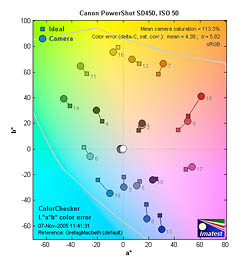 |
| In the diagram above, the squares show the original color, and the circles show the color that the camera captured. More saturated colors are located towards the periphery of the graph. Hue changes as you travel around the center. Thus, hue-accurate, highly saturated colors appear as lines radiating from the center. |
The other important part of color rendition is hue accuracy. Hue is "what color" the color is. Here, the Canon SD450 again did quite well. Hues were generally very accurate, apart from the shifting of cyans towards pure blue, a common tactic to produce more pleasing sky colors.
Our random "Gallery" shots showed very pleasing color across a wide variety of subjects. (See our Canon PowerShot SD450 Photo Gallery for more shots taken with the camera.)
Viewfinder
Coverage
Optical viewfinder is very tight and skewed to the lower right. Very good accuracy from the LCD monitor though.
| 35mm eq., optical viewfinder | 105mm eq., optical viewfinder |
| 35mm eq., LCD monitor | 105mm eq., LCD monitor |
The Canon SD450's optical viewfinder was very tight, showing only about 73% frame accuracy at wide angle and 77% accuracy at telephoto lens settings. However, the LCD monitor showed very close to 100 percent frame accuracy, though our standard measurement lines were just barely out of frame in the final shot. The LCD accuracy is great, but the optical viewfinder leaves a great deal to be desired.
Flash
Coverage and Range
A weak flash, though our test shots require slightly less exposure compensation than average.
| 35mm equivalent | 105mm equivalent |
| Normal Flash +0.7 EV | Slow-Sync Mode +0.7 EV |
Flash coverage was rather uneven at wide angle but very good at telephoto. In the Indoor test, the flash on the Canon SD450 underexposed our subject at its default setting, requiring a +0.7 EV exposure compensation adjustment to get bright results. Even here, the exposure is a little dim, with a strong orange cast. The Slow-Sync flash mode produced slightly brighter and more even results, though with a stronger orange cast from the room lighting. As with the normal flash mode, the Slow-Sync flash also required a +0.7 EV adjustment.
| 8 ft | 9 ft | 10 ft | 11 ft | 12 ft | 13 ft | 14 ft |
1/60 sec f4.9 |
1/60 sec f4.9 |
1/60 sec f4.9 |
1/60 sec f4.9 |
1/60 sec f4.9 |
1/60 sec f4.9 |
1/60 sec f4.9 |
Even at eight feet, our closest test range, the SD450's flash was a little dim. Intensity decreased with each additional foot of distance. This agrees pretty well with Canon's stated flash range specs, which vary from 12 feet with the lens in its wide angle position to only 6.6 feet with the lens set to telephoto. (Most compact digital cameras have rather limited flash ranges.)
Output Quality
Print Quality
Good print quality, great color, very usable 11x14 inch prints. ISO 400 images are very soft at 8x10, acceptable at 5x7, great at 4x6.
Testing hundreds of digital cameras, we've found that you can only tell just so much about a camera's image quality by viewing its images on-screen. Ultimately, there's no substitute for printing a lot of images and examining them closely. For this reason, we now routinely print sample images from the cameras we test on our Canon i9900 studio printer, and on the Canon iP5000 here in the office. (See the Canon i9900 review for details on that model.)
The Canon SD450 had enough resolution to make very crisp 8x10 inch prints. At 11x14, its prints were a bit softer looking, but more than adequate for wall or table display. At high ISO, image noise increased somewhat, and the images softened as the camera tried to suppress the image noise. The SD450 managed the trade-off between noise and sharpness pretty well though. When printed, ISO 200 shots look a little soft but quite acceptable at 8x10 inches, and are very good at 5x7. ISO 400 images are a little noisy but probably acceptable for most people at 5x7 inches, and look good at 4x6.
Color-wise, the SD450's images looked just great. Reds did tend to get a little hot-looking, but on the whole, its color was really excellent. Images printed on the i9900 looked bright and vibrant, without appearing the least bit artificial. We think most consumers would find the SD450's color rendition very appealing.
Timing and Performance
Canon SD450 Timing
Good to average speed for a consumer camera.
| Startup/Shutdown: | |
| Power On to first shot | 1.2 seconds |
| Shutter response (Lag Time): | |
| Full Autofocus Wide |
0.50 second |
| Full Autofocus Tele |
0.90 second |
| Prefocused |
0.070 second |
| Cycle time (shot to shot) | |
| Normal large/fine JPEG | 1.38 seconds |
| Flash recycling | 6 seconds |
| Continuous mode | 0.48 second 2.09 frames/second (buffer clears instantly) |
| Download speed | |
| Windows Computer, USB 2.0 | 1,859 KBytes/sec |
The Canon SD450's performance is about average, with a pretty quick startup time of 1.2 seconds. Shutter response at wide angle is on the fast side of average, while at telephoto they're just a little on the slow side. If you "prefocus" the camera by half-pressing and holding down the shutter button before the final exposure, it's blazingly fast, with a shutter delay of only 0.070 second. Shot to shot cycle times are a little faster than average for this class of camera, at about 1.38 seconds for large/fine JPEGs, and the buffer clears almost immediately after each shot. Continuous-mode speed is moderate, at a bit over two frames/second, though again, the buffer clears almost instantaneously. The flash takes about six seconds to recharge after a full-power shot, again about average for this class of camera. Connected to a computer, download speeds are quite fast at 1,859 KB per second. Bottom line, while not a first choice for sports or other fast-paced action, the SD450 is responsive enough to handle most family photo opportunities.
Battery and Storage Capacity
Battery
Short battery life with the LCD on, very good when LCD is switched off. (Plan on buying a second battery though.)
The Canon SD450 uses a custom rechargeable LiIon battery for power.
| |
|
| Still-image capture mode LCD on |
150 images |
| Still-image capture mode LCD off |
500 images |
| Image playback LCD on |
3 hours |
The PowerShot SD550 uses a custom rechargeable 790mAh Lithium Ion battery for power, so we weren't able to conduct our usual direct measurements of power consumption. The table above shows maximum number of photos and playback time, based on the CIPA standard. Battery life is quite good with the LCD turned off, but given the poor accuracy of the optical viewfinder, you'll probably find yourself using the LCD most of the time. In light of this, our usual recommendation to purchase a second battery at the same time as the camera applies doubly.
Storage
The Canon PowerShot SD450 comes with a 16MB SD card.
| 16MB SD card |
Fine | |
| 2,592 x 1,944 | Images | 6 |
| File Size | 2.6MB | |
| 2,048 x 1,536 | Images | 9 |
| File Size | 1.7MB | |
| 1,600 x 1,200 | Images | 15 |
| File Size | 1.1MB | |
| |
Images | 56 |
| File Size | 281KB | |
I strongly recommend buying at least a 128MB card, preferably a 256MB one, to give yourself extra space for extended outings.
| Pro: | Con: |
|---|---|
|
|
| Free Photo Lessons | |
|


Follow Imaging Resource: